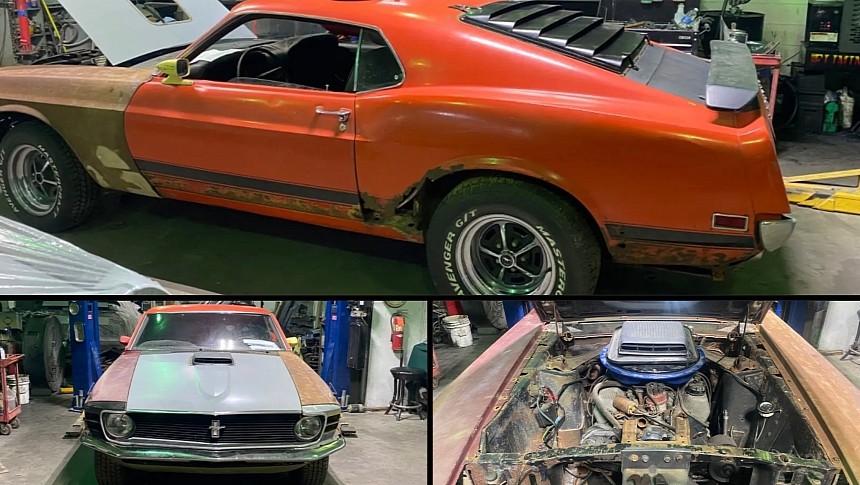The 1969 model year brought a trio of fantastic Mustangs into showrooms. Ford introduced the Mach 1 as a performance-oriented option and launched a couple of limited-edition rigs for homologation purposes. I'm talking about the Boss twins.
While the Mach 1 was available with a selection of V8 units, the Boss 429 and Boss 302 had exclusive mills. The Boss 429 broke cover with a 429-cubic-inch (7.0-liter) V8 that Ford designed specifically for NASCAR. Rated at 375 horsepower, it was the company's most potent engine during the golden muscle car era.
The Boss 302, on the other hand, wasn't just about the powerplant. Ford put it into production to homologate an entire car for the SCCA Trans-Am series. The division limited displacement to 305 cubic inches (5.0 liters), so Ford assembled the solid-lifter 302 (4.9 liters) with Cleveland-style heads and larger valves.
The unit generated 290 horsepower in a Mustang fitted with many race-honed and lightweight features. The Boss 302 package turned the pony into a competitor for the popular Chevrolet Camaro Z28.
Unlike the Mach 1, the Boss twins were produced in limited numbers. The Boss 429 saw daylight in 1,358 units, while the Boss 302 moved 8,642 examples. Both were offered in 1969 and 1970. As a result, these homologation specials are far more desirable than the Mach 1, even when compared to the Cobra Jet cars.
But just because they're rare and desirable doesn't mean all these vehicles had a good life. They weren't very valuable decades ago, so many of them were crashed, abandoned, or stored improperly. The 1970 example you see here is one of those cars.
Currently looking for a new home from Floyd, Virginia, this Boss 302 had a rough life. Not only has it lost some original components, but it's also quite rusty. And never mind the rot on the lower body panels; this 'Stang has a few holes in the floor, and the frame needs a lot of work. Most of the interior is in solid condition, though.
As for what's under the hood, there's good news and bad news. The good news is that this Boss 302 still rocks a correct 302-cubic-inch V8 with a four-speed manual transmission. The bad news is neither are numbers-matching. It's not all that terrible since both are period-correct, but it's a detail that will lower the car's value following a restoration.
Speaking of which, is this Mustang worth all the effort and cash that will go into such a demanding project? Well, it's safe to say it may swallow more dough than its market value as a restored classic, so it will have to be a labor of love before anything else. On the flip side, the 1970 Boss 302 is a relatively rare vehicle with 7,014 units made, and its market value will increase.
If you want to save this SCCA-spec pony, you'll have to go against other bidders and pay more than $8,000 as of this writing. The reserve hasn't been met, and the "buy it now" price is $28,500. A bit steep, maybe?
The Boss 302, on the other hand, wasn't just about the powerplant. Ford put it into production to homologate an entire car for the SCCA Trans-Am series. The division limited displacement to 305 cubic inches (5.0 liters), so Ford assembled the solid-lifter 302 (4.9 liters) with Cleveland-style heads and larger valves.
The unit generated 290 horsepower in a Mustang fitted with many race-honed and lightweight features. The Boss 302 package turned the pony into a competitor for the popular Chevrolet Camaro Z28.
Unlike the Mach 1, the Boss twins were produced in limited numbers. The Boss 429 saw daylight in 1,358 units, while the Boss 302 moved 8,642 examples. Both were offered in 1969 and 1970. As a result, these homologation specials are far more desirable than the Mach 1, even when compared to the Cobra Jet cars.
But just because they're rare and desirable doesn't mean all these vehicles had a good life. They weren't very valuable decades ago, so many of them were crashed, abandoned, or stored improperly. The 1970 example you see here is one of those cars.
Currently looking for a new home from Floyd, Virginia, this Boss 302 had a rough life. Not only has it lost some original components, but it's also quite rusty. And never mind the rot on the lower body panels; this 'Stang has a few holes in the floor, and the frame needs a lot of work. Most of the interior is in solid condition, though.
As for what's under the hood, there's good news and bad news. The good news is that this Boss 302 still rocks a correct 302-cubic-inch V8 with a four-speed manual transmission. The bad news is neither are numbers-matching. It's not all that terrible since both are period-correct, but it's a detail that will lower the car's value following a restoration.
Speaking of which, is this Mustang worth all the effort and cash that will go into such a demanding project? Well, it's safe to say it may swallow more dough than its market value as a restored classic, so it will have to be a labor of love before anything else. On the flip side, the 1970 Boss 302 is a relatively rare vehicle with 7,014 units made, and its market value will increase.
If you want to save this SCCA-spec pony, you'll have to go against other bidders and pay more than $8,000 as of this writing. The reserve hasn't been met, and the "buy it now" price is $28,500. A bit steep, maybe?











